Is there anyone who can resist a composition book? I can’t, even though in some ways they really don’t fit into my notebook usage patterns these days. They aren’t my favorite size, they aren’t my favorite shape, and it’s sometimes hard to find ones that aren’t wide-rule lined, but I love them anyway. I admire the way other people use them, such as Michael Bierut:

(Michael Bierut’s 26 Years, 85 Notebooks)
and Lynda Barry:
Occasionally I’m tempted by the big stacks of cheapo composition books in crazy colors and designs that Staples promotes for back to school, but I know I won’t use them, so I manage to resist. However, for research purposes at least, I allowed myself to purchase two composition books recently. If you search “composition book” on Amazon, the results are a dizzying array of styles and brands. But I focused on two particular models, both by Roaring Spring:
The unlined basic Composition Notebook (also available in graph, lined, and some other variations)
The unlined Premium Composition Notebook (also available in a graph ruled version and lined)
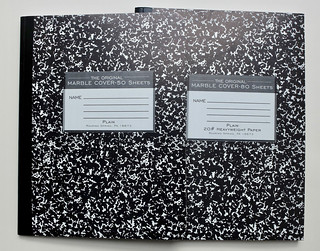
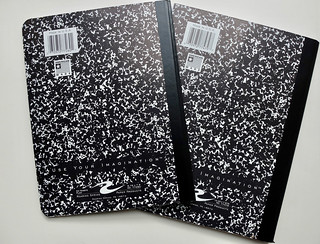
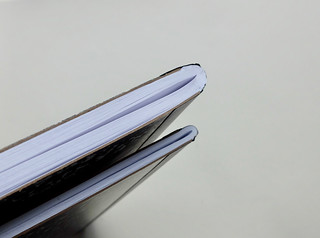
Both are made in the USA and have the classic composition book design with a black and white patterned cover, single stitched signature and taped spine. Both have a class schedule grid printed on the inside front cover (though designed a little differently). Both have bright cool white paper. But here are the differences:
The Premium model is 10.25 x 7.875″ and 80 pages. It has squared corners. The paper is said to be “heavyweight,” and specified as 20#. The inside back cover is blank.
The regular model is 9.75 x 7.5″ and 50 pages, with rounded corners. No paper weight is specified on the notebook itself, but the description on Amazon says it is 15#. The inside back cover has conversion, multiplication and measurement tables.
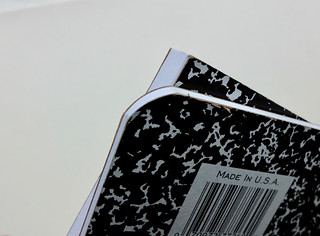


And here’s how the different papers perform (with the premium heavyweight paper on the right in the photos below, in case it’s not obvious!):
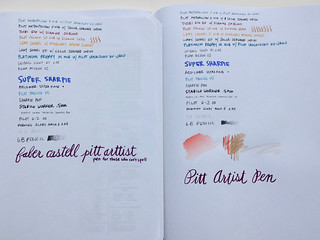
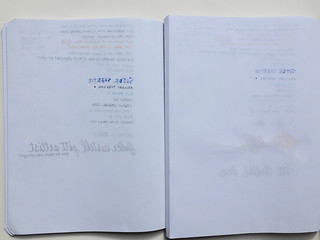
Pretty striking, isn’t it? The heavyweight paper in the premium version only bleeds in a few spots with fountain pens, and generally has less bleed-through and show-through. It’s still not artist-grade paper by any means, but it can even handle a little light watercolor. The regular paper is pretty flimsy, with a lot of bleed.
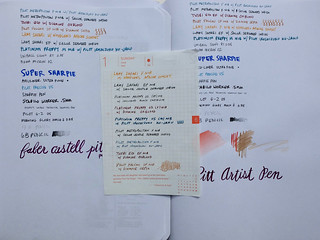
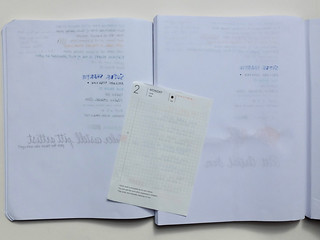
The Premium Roaring Brook composition book really delivers a lot more value if you can catch it at a good price– I’ve sometimes seen it as high as $13 but often it is within a dollar or two of the regular version, around $6 or so, depending on the page format. Just make sure you are shopping carefully online so you get the correct version! Here are links with current pricing at Amazon:
Premium graph ruled:
Premium college ruled:
Premium plain/unlined:
Here are links for the regular version if you prefer the smaller, rounded-corner format:
Regular graph ruled:
Regular wide ruled with margin:
Regular plain/unlined:


I went though a composition book phase and recently noticed the Mead notebooks I used to buy from my local pharmacy are now of a lower quality and the back reads “Made in China.” It is very disheartening to see so many brands dropping in quality. I guess Amazon still has the old batches for now…
I’ve always liked Roaring Springs paper. I wouldn’t mind getting myself a few of these.
Hello,
Our institution acting as potential buyer of your products and services,request a quote for the following product (s)-
(1) Mead Composition Book 7 1/2″ x 9 3/4″ 70 double-inside white sheets with blue ruling for 140 pages of notes—-(QTY 20,000)
Please revert back to me with all relevant information, options, and suitable alternatives.
Note: In addition to the above,Our institution standard Payment terms:Net 30 days from the date of supply with the supplier’s Invoice.
Regards,
Jacob Kavunkal
Procurement Director
University of Maryland
223 Arch Street, Office
Baltimore, MD 21231
Phone:(410) 670-0894
Email: quotes@umd-edu.com